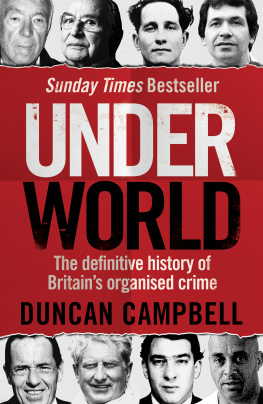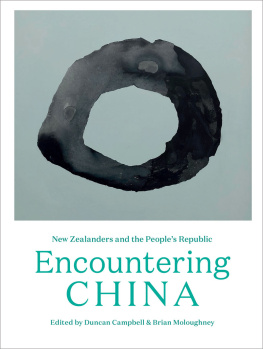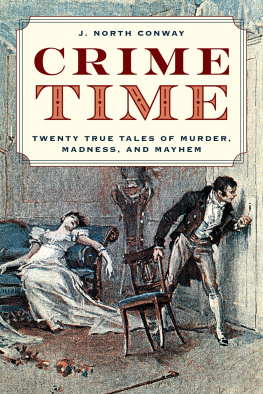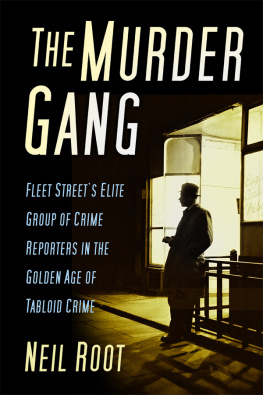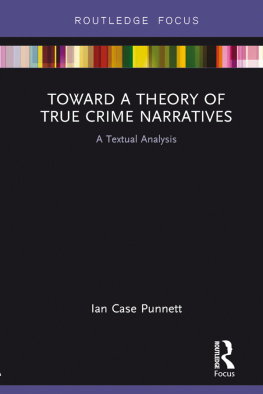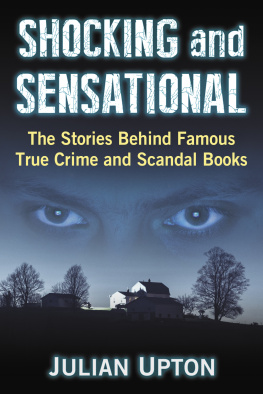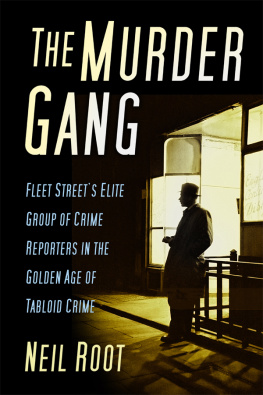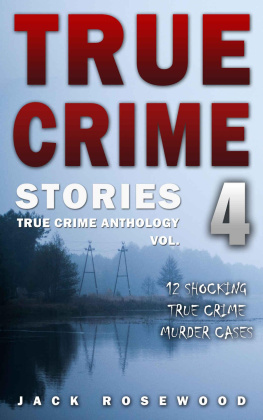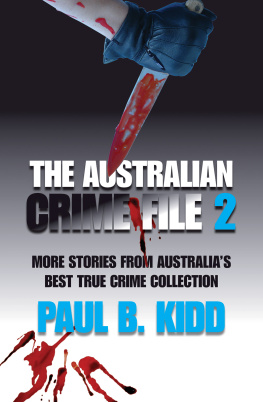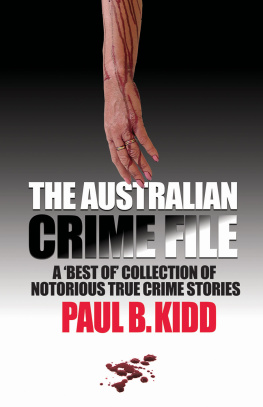

Contents
Introduction
W herever God erects a house of prayer, wrote an early crime reporter called Daniel Defoe, the Devil always builds a chapel there; And twill be found, upon examination, The latter has the largest congregation.
The same applies to the news stories of crime and the underworld have, for centuries, attracted the largest of readerships. But how did people become so interested in all those devilish miscreants the bandits, the highwaymen, the murderers, the outlaws, the gangsters, the robbers, the cat-burglars, the conmen, the getaway drivers, the men and women who broke all the rules?
The Bible described how Adam and Eve were caught stealing forbidden fruit. Was that the first crime report? Was their banishment the earliest coverage of a criminal sentence, and was the killing of Abel by Cain the original murder story to whet the appetite of the reading public?
Crime reporting has been a staple of news since the first newsbooks, chapbooks and broadsides, as the early forms of the press were known, were sold in the wake of public hangings centuries ago, some of them initially read aloud for the benefit of the illiterate. From the capture of the highwayman, Dick Turpin, and the execution of the great escaper, Jack Sheppard, in the eighteenth century, to the hunt for Jack the Ripper and the scandal of child prostitution in Victorian England, to the Brides in the Bath murders during the First World War, the Old Bailey trial of the Kray twins in the 1960s and the funerals of the great train robbers in the 2010s, the fascination with the transgressive has remained unabated. Some themes are constant. Crime in England this century has increased 400 per cent, in Ireland 800 per cent and in Scotland above 3,500 per cent, Blackwoods Magazine told its readers in 1844. The causes were clear. Big cities were partly to blame because restraint of character, relationship and vicinity are lost in the urban crowd but there were other culprits: the employment of women has destroyed the familial bond, emancipating the young from parental control. Twenty years later, another factor in the growth of crime was spotted by The Times: under the influence of philanthropic sentiments and hopeful policy we have deprived the law of its terrors and justice of its arms. A century and a half on, panic about lawlessness, dismay at the behaviour of the young and criticism of over-lenient punishments still provide a backdrop to the coverage of crime.
Why such interest? Why does the old news-desk motto, if it bleeds, it leads, still hold true? The writer Thomas De Quincey, in his famous satirical essay Murder Considered As One of the Fine Arts, published in Blackwoods Magazine in 1827, wrote of how he came across the case of John Williams, accused of killing seven people in east London in what were known as the Ratcliffe Highway murders: in came the London morning papers, by which it appeared that, but three days before, a murder the most superb of the century by many degrees had occurred in the heart of London. In a postscript published in 1854, De Quincey added: [E]very day of the year we take up a paper, we read the opening of a murder. We say, this is good, this is charming, this is excellent!
Charles Dickens, in a letter to the Daily News on 28 February 1846, on the subject of the death penalty, noted that there is about it a horrible fascination, which, in the minds... of good and virtuous and well-conducted people, supersedes the horror legitimately attracting to crime itself, and causes every word and action of a criminal under sentence of death to be the subject of a morbid interest and curiosity. He felt that such reports were published because they are read and sought for... it is in the secret nature of those of whom society is made up, to have a dark and dreadful interest in the punishment at issue. A decade later, in his poem Bishop Blougrams Apology, Robert Browning returned to the theme: Our interests on the dangerous edge of things./The honest thief, the tender murderer,/the superstitious atheist. And an interest in dark and dreadful criminals and far from tender murderers has been cited as one factor in increasing literacy in Britain in the wake of the Education Acts of 1870 and 1880, when the press reported every detail of the wicked offenders and their progress to the scaffold.
Newspapers themselves pondered on the fascination and sought to justify it in different ways. This appetite of the mind for particulars of great crimes and criminals has been stigmatised as vulgar, said the Daily Telegraph in 1881, after running tens of thousands of words on the case of a murderer called Percy Lefroy Mapleton, who killed a man in the first-class carriage of the Brighton to London train. It is only vulgar in so far as it is universal, the common attribute of every age, people and clime. The Athenians, it was suggested, were just like us because they were thrilled by Sophocles Oedipus the King and the fact that he had killed his father and married his mother. The paper concluded that public attention dwells on the life story of a great criminal as it hunts out the moral of a literary or pictorial satire. In both cases the analytical faculty stimulates the intellect to an exhaustive inquiry. Well, up to a point. But certainly the ways in which crime is reported over the centuries, the language used, the judgments made, the prejudices revealed, create their own rich history.
Crime is, in many ways, the prism through which we see society and its anxieties and phobias. What are the most egregious offences? How should they be punished? Are offenders bad or mad? In 1910, a young Home Secretary, Winston Churchill, made a speech in which he explained: the mood and temper of the public in regard to the treatment of crime and criminals is one of the most unfailing tests of the civilisation of any country. Crime reports are a running commentary on those unfailing tests. And the crimes reported deal with the most visceral emotions hate, love, greed, desire, fear, jealousy, anger, revenge, redemption, compassion and shine a light on a nations attitudes to sex, race, gender, religion, property, wealth and power.
A day in a magistrates court provides as illuminating a snapshot as any lengthy think-tank report or ministerial briefing on the state of education, immigration, unemployment, drug use, alcoholism, mental health and popular culture, not to mention policing, the criminal justice system and the failures or successes of government policies. Nor is it a grim beat; the phrase gallows humour did not come from nowhere. Life and death. Human nature. Drama. As Mitchell Stephens noted in his book A History of News, criminals and their victims, even given the heavy-handedness of most crime coverage, may be the most fully drawn characters in the news. And as Edgar Wallace, himself a crime reporter before becoming the best-selling author in Britain, remarked: My experience of crime reporting taught me a great deal about humanity that has been very useful to me. No wonder the television channels overflow every day with fictional and non-fictional criminals and detectives.
Is it a British thing? Murder certainly seems to be, despite or perhaps because of the fact that our murder rates are low and detection rates high. The title of this book comes from a catch-phrase uttered by a character called Minnie Bannister in the 1950s BBC radio comedy series The Goon Show. Everyone laughed when Minnie said it, not least because no one thought there was a possibility of it ever happening to them. Death in particular seems to provide the minds of the Anglo-Saxon race with a greater fund of innocent amusement than any other single subject, wrote Dorothy L. Sayers in 1934, in a preface to a short stories collection of mystery, detection and horror. She was writing about its fictional portrayal but murder and its detection and punishment has been responsible for the sales of countless newspapers. The abolition of the death penalty in 1965 was blamed by at least one Fleet Street editor for the subsequent decline in the sales of evening papers.
Next page

